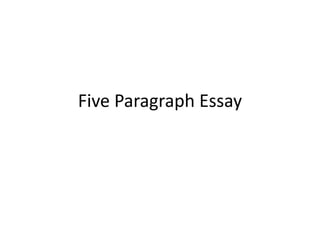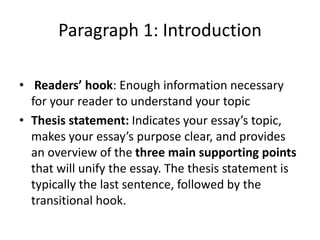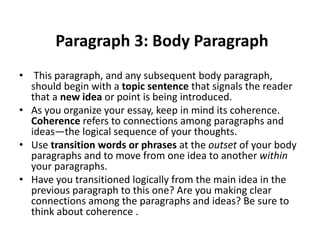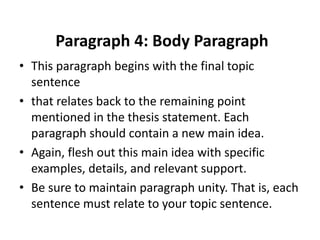Five Paragraph Essay.pptx
- 2. Paragraph 1: Introduction ? ReadersĄŊ hook: Enough information necessary for your reader to understand your topic ? Thesis statement: Indicates your essayĄŊs topic, makes your essayĄŊs purpose clear, and provides an overview of the three main supporting points that will unify the essay. The thesis statement is typically the last sentence, followed by the transitional hook.
- 3. Paragraph 2: Body Paragraph ? Begins with a topic sentence that identifies one main idea that will be discussed as support or proof for the thesis statement ? Supporting sentences use specific details, demonstrated through closely related examples or evidence, to expand and explain the main idea. Generally, a well-developed paragraph has at least five to eight sentences. ? Paragraph unity means that all ideas in a paragraph are closely related to its topic sentence and further develop that topic sentence. That is, all sentences in a single paragraph must be unified around a central point or idea.
- 4. Paragraph 3: Body Paragraph ? This paragraph, and any subsequent body paragraph, should begin with a topic sentence that signals the reader that a new idea or point is being introduced. ? As you organize your essay, keep in mind its coherence. Coherence refers to connections among paragraphs and ideasĄŠthe logical sequence of your thoughts. ? Use transition words or phrases at the outset of your body paragraphs and to move from one idea to another within your paragraphs. ? Have you transitioned logically from the main idea in the previous paragraph to this one? Are you making clear connections among the paragraphs and ideas? Be sure to think about coherence .
- 5. Paragraph 4: Body Paragraph ? This paragraph begins with the final topic sentence ? that relates back to the remaining point mentioned in the thesis statement. Each paragraph should contain a new main idea. ? Again, flesh out this main idea with specific examples, details, and relevant support. ? Be sure to maintain paragraph unity. That is, each sentence must relate to your topic sentence.
- 6. Paragraph 5: Conclusion ? The conclusion revisits your overall purpose for writing and often invites your reader to consider the implications of why your ideas are significant. ? The conclusion may ? restate the thesis or ? summarize the essayĄŊs major points and ? leaves the reader with a final thought to ponder. ? If you choose to restate the thesis or summarize the essayĄŊs main ideas, do not repeat the same wording from the introduction or body paragraphs. ? Remember not to introduce new, unrelated ideas in the conclusion.
- 7. cause and effect essay ? deals with ĄŪwhy thingsĄŊ ĻC why something happened and what was the result ? Overcrowded cities ? What effects has the computer had on our lives? ? Cell phone use can improve family relations.
- 8. ? Cause ? in the event that ? granted (that) ? as / so long as ? on (the) condition (that) ? for the purpose of ? with this intention ? with this in mind ? in the hope that ? to the end that ? for fear that ? in order to ? seeing / being that ? in view of ? If... then ? unless when whenever while because of as since while lest in case provided that given that only / even if so that so as to owing to inasmuch as due to ? Effect ? as a result ? under those circumstances ? in that case ? for this reason ? in effect ? for ? thus ? because the ? then ? hence ? consequently ? therefore ? thereupon ? forthwith ? accordingly ? henceforth







